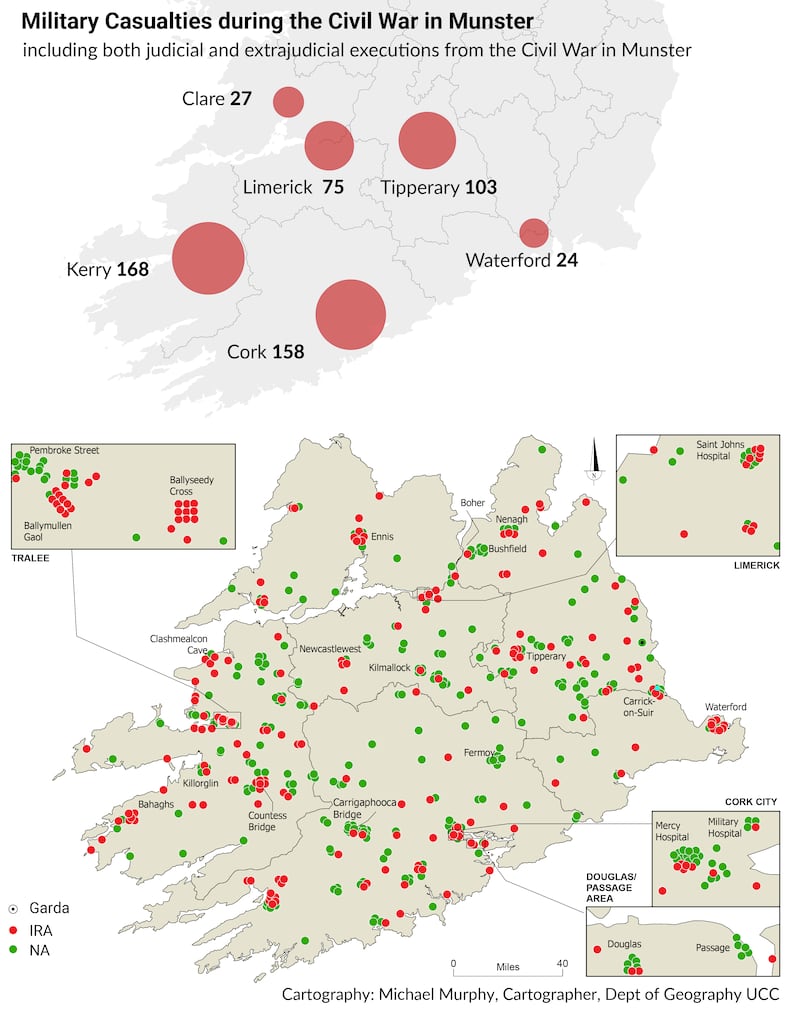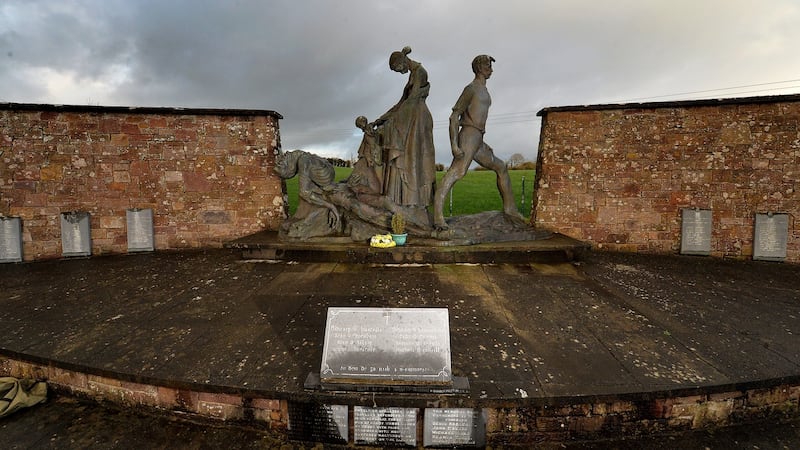The emerging Irish Free state was far more severe in dealing with the anti-Treaty IRA during the Civil War than the British had been when dealing with the IRA during the War of Independence, a symposium to mark the centenary of the execution of leading republican, Dick Barrett, has heard.
Dr Andy Bielenberg of the School of History at UCC said that it was clear from a study that he was currently undertaking with independent historian John Dorney on Civil War casualties in Munster that the Free State forces prosecuted the Civil War often without recourse to any legal process.
“The emerging new state was far more severe than the British regime had been, particularly with regard to executions, both official and unofficial, and the extent of incarceration. Due legal process was evidently not followed,” he said.
According to Dr Bielenberg, civil law had effectively broken down during the Civil War and the National Army was handed responsibility at a time when the state was not fully constituted from a legal perspective and exceptional legal powers were vested in the army.
RM Block
“Execution, official and unofficial, became a weapon of war, exercised in reprisals, counter reprisals thinly dressed up as military justice. This atrocious legal situation was justified on the grounds that it was absolutely necessary to achieve law and order and secure the very survival of the state.”

Dr Bielenberg said that the Emergency Powers Bill enacted by the Provisional Government on September 27th, 1922, instituted military courts with the power to sentence to death anyone caught in possession of arms or aiding and abetting attacks on Government forces.
“Under the new military laws passed, at least 77 were subsequently executed. Many more anti-Treaty IRA men were killed in what were effectively ad hoc extrajudicial killings with many occurring in custody,” said Dr Bielenberg.
“Todd Andrews [War of Independence and Anti-Treaty IRA Civil War veteran] claimed that there was as many as 153 of these ‘unauthorised killings’ – if this figure is accurate, it is not implausible that 45 per cent of the killings of anti-Treaty IRA men were essentially assassinations of persons in custody.”
Dr Bielenberg said that although his work with Mr Dorney on Civil War casualties in Munster was still at preliminary stage, they had been able to establish that at least 555 combatants from both sides, including those executed judicially and extrajudicially, were killed during the conflict in the province.
The research suggested that the Civil War was prosecuted far more vigorously in Kerry, Cork and Tipperary than in Limerick, Clare and Waterford with preliminary figures suggesting 168 combatants were killed in Kerry, 158 in Cork, 103 in Tipperary, 75 in Limerick, 27 in Clare and 24 in Waterford.*
He said that they found that some 77 per cent of all combat fatalities in the Civil War in Munster were in Kerry, Cork and Tipperary with only 23 per cent in Limerick, Clare and Waterford and although Limerick was initially an important theatre in the war, it was effectively cleared by the end of August 1922.
Although part of the anti-Treaty IRA’s Munster Republic, Clare and Waterford were particularly quiet counties, accounting for only 9 per cent of Munster combat fatalities and, as such, they were probably more typical of most southern counties outside of Dublin, he said.
Another notable feature of the war in Munster, which probably reflected wider national trends, was that the National Army suffered a higher share of fatalities relative to the anti-Treaty IRA, accounting for over 60 per cent of all combatant deaths across the near eleven months of the conflict.
Dr Bielenberg said that this may be in part due to the fact that there was better recording of National Army fatalities due to the nature of the sources such as archive material, but the nature of the combat was also likely to have been a factor in the disparity.

“The side taking the more offensive strategy suffered higher casualty levels and was seemingly more willing to take military strategies which had a higher cost in terms of fatalities. This is especially more so when we take out those who were assassinated in custody.”
Looking at the timing of fatalities was also revealing in that there were three distinct “phases” to the war, the Conventional Phase from the end of June until the end of August 1922, the Guerrilla Phase from the start of September until the end of 1922 and the End Game from January to May 1923.
In Limerick, for example, over 61 per cent of all fatalities in the entire Civil War occurred during the initial Conventional Phase between late June and the end of August 1922, the highest of any of the Munster counties in that phase but Limerick had a very low level of fatalities thereafter.
In contrast, the highest number of fatalities in Cork was during the Guerrilla Phase from September 1922 until the end of December 1922, accounting for almost 59 per cent of all combatant deaths in Cork, coinciding with when anti-Treaty IRA resistance was strongest in north Cork and West Cork.
But matters quietened down in Cork in 1923 and National Army intelligence files for the county indicate that there were only a few pockets of anti-Treaty IRA resistance left in West Cork at this stage and relatively fewer people were therefore killed in the county in 1923 compared to 1922.
In contrast, in Kerry the highest level of deaths occurred in the final phase of the conflict in 1923 when over 49% of all fatalities for the Civil War in the county were recorded, revealing that the final phase was the most intense phase here.
Dr Bielenberg said that this was supported by individual accounts such as that of War of Independence and anti-Treaty Civil War veteran, Jeremiah Murphy from Barraduff in East Kerry in his posthumously published memoir, “When Youth was Mine”.
Murphy observed that the anti-Treaty IRA was safe in secluded valleys in the hills but not in the lowlands by the end of 1922 and was still a potent force in the county while the National Army was slow to pursue them in the winter months until the spring of 1923.
“Some of the worst cases (of assassinations of anti-Treaty IRA in custody) occurred in Kerry in 1923, notably at Ballyseedy, [near Tralee] Countess Bridge [near Killarney] and Bahaghs [in Cahersiveen] where prisoners were collectively blown to pieces with mines,” said Dr Bielenberg.
“Anti-Treaty republicans for their part utilised trap mines which result in some atrocious casualties on the National Army side also ... this type of mine was deployed at Knocknagoshel which killed five and reprisals resulted from these [type of] attacks,” he said.
Dr Bielenberg said that 12 anti-Treaty IRA prisoners were killed in mine explosions at Ballyseedy and Countess Bridge in reprisal for Knocknagoshel and the killings were covered up by the National Army with no inquests being carried out by a medical doctor into those killed in such explosions.
Kerry accounted for well over a third of these ad hoc executions nationally during the Civil War while Munster accounted for about half of all these unofficial executions during the conflict nationally and by May 1923, most anti-Treaty IRA republicans were either scattered, in jail or dead.
“Fatalities, most notably executions played a part in wearing down republican morale, but the huge numbers incarcerated was probably a bigger factor in crushing anti-Treaty resistance which ended with the dump arms order on May 23rd, 1923,” he said.
Dr Bielenberg was speaking at a symposium organised jointly by the School of History and the Dick Barrett Commemoration Committee as part of a series of commemorative events to mark the centenary of the execution of Dick Barrett by the Provisional Government on December 8th, 1922.
*This article was amended on December 4th, 2022




















